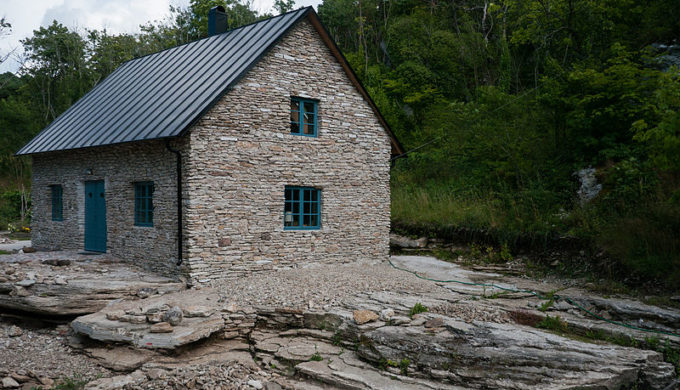Check out many of the courthouses, churches, and city buildings throughout Texas Hill Country towns. Typically, the buildings appear bright white, but they aren’t painted to look that way. Limestone buildings are a common sight in this area. But, why limestone? Why not granite, like the capitol building in Austin? Find out why limestone buildings are so popular throughout the Texas Hill Country.
History
Limestone Buildings: Why Are They So Popular in the Texas Hill Country?
A Common Material

Photo: Wikimedia Commons
Drive along almost any of the roads in the Texas Hill Country and look for places where the road cut into the native rock. You’ll likely see pale white stone looking out from these cut areas. This limestone is prevalent throughout the Hill Country. One of the main reasons Texans opted for limestone buildings was simply because that was the material at hand. It seems almost every county has a limestone quarry that either is currently active or once was in the past. These numerous local quarries could supply the building materials for nearby towns without incurring the cost of using foreign stone.
Caliche Sometimes Confused for Limestone

Photo: Wikimedia Commons
Caliche is another bright white material used in buildings in the Texas Hill Country. You’ve likely seen other constructions with this material before as it’s used in Portland cement and in the pyramids at Giza. Caliche has calcium carbonate in it, which means its composition is like limestone. Unlike certain limestones, you won’t see fossils in caliche.
Differences Between Caliche and Limestone

Photo: Wikimedia Commons
The two differ in their formations. When rain falls, it contains small amounts of calcium carbonate, and if the region is dry, the water evaporates, leaving the calcium behind. After some time of this, the soil appears white from so much calcium carbonate. Over thousands of years, this caliche deposit builds up, and pressure from the overlying rock compresses the caliche into a rock layer, which may be used for construction. Limestone, however, is formed from sediments at the bottom of the inland sea that existed millions of years ago. The calcium-containing shells of tiny sea creatures on the seafloor were compressed together over time, creating the limestone. Occasionally, the seashells and sea creature bodies did not become compressed but formed indentations in the limestone, resulting in fossil imprints. Look for these on some limestone buildings around Texas.
A Limestone Capitol?

Photo: Wikimedia Commons
Limestone was such a common material that even the Austin capitol building was originally supposed to be made of limestone, like many other buildings in the Hill Country. In 1888, however, a large enough supply of limestone for the massive building, leading to the decision to opt for granite instead.
How Limestone Got From Quarries to Buildings

Photo: Wikimedia Commons
Limestone’s journey from quarries to buildings is interesting, and it explains some of the features you see in limestone buildings. For buildings constructed in the 1800s, power tools did not exist, so they had to get creative with their stone cutting techniques. Luckily, limestone is relatively soft compared to other stones and cuts more easily. To get the limestone out of the ground and into precise blocks, the quarry workers would drill holes large enough to fit poles made of local cedar or cypress. After dousing the wood with water, the wood would gently expand and predictably split the stone. Workers also added holes to the sides of the limestone blocks to accommodate tongs, which would grip the block, allowing it to be lifted or moved with ease. These drilled and chipped holes remained in the limestone even after it was used in the building, and you may see some of them if you look closely at limestone buildings around the Hill Country. To get the stone from the quarry to the construction site, workers would load it onto wagons, which transported the material to its final destination. Using a locally available stone made this journey faster and reduced overall costs.



